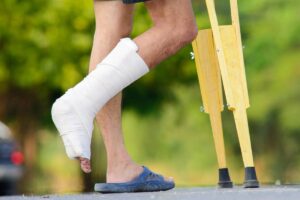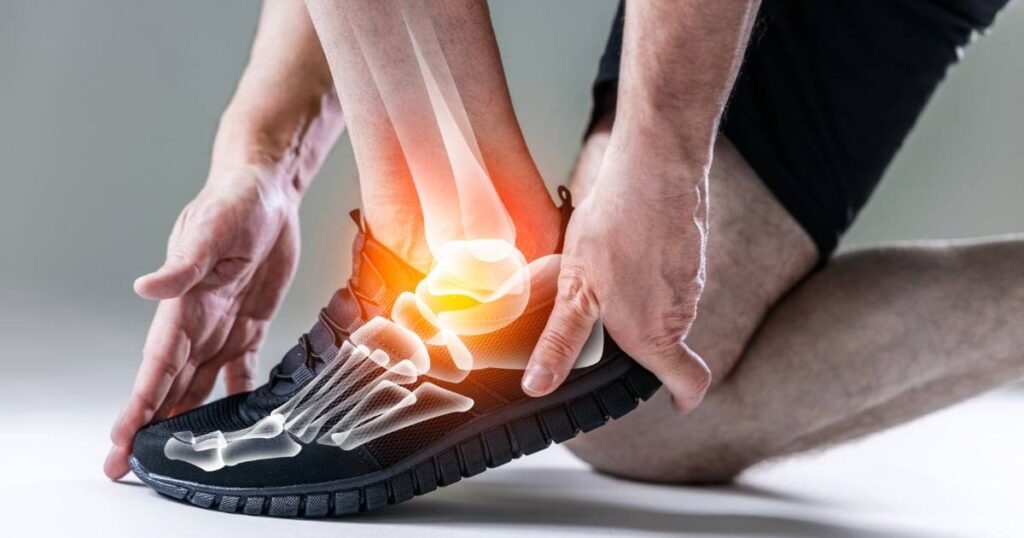Do you often experience pain in your feet or ankles? Is walking, running, or even standing for long periods becoming increasingly difficult? This isn’t something to ignore. If you’ve been struggling with this type of pain, you might need help from an orthopedic surgeon.
In this blog, we’ll explore how orthopedic surgeons can help relieve foot and ankle pain and where you can find the right specialist to assist you. Keep reading to find out how you can take control of your foot and ankle health and start living pain-free!
Contents
- 1 Common Causes of Foot and Ankle Pain
- 2 How an Orthopedic Surgeon Diagnoses Foot and Ankle Pain
- 3 How an Orthopedic Surgeon Helps Relieve Foot and Ankle Pain
- 4 How to Prevent Foot and Ankle Pain
- 5 When Should You See an Orthopedic Surgeon for Foot and Ankle Pain?
- 6 Where to Find an Orthopedic Surgeon for Foot and Ankle Pain
Common Causes of Foot and Ankle Pain
 Foot and ankle pain can be caused by several conditions, each affecting the bones, muscles, tendons, or ligaments. Here are some of the most common causes of foot and ankle pain:
Foot and ankle pain can be caused by several conditions, each affecting the bones, muscles, tendons, or ligaments. Here are some of the most common causes of foot and ankle pain:
-
Sprains
A sprain occurs when ligaments are stretched or torn due to twisting or overextending the foot or ankle. This often leads to pain, swelling, and bruising. -
Fractures
Fractures or broken bones in the foot or ankle can result from trauma, falls, or accidents. A fracture can cause severe pain, swelling, and difficulty moving the foot or ankle. -
Arthritis
Osteoarthritis and rheumatoid arthritis can cause joint pain and stiffness in the foot and ankle. Arthritis in these areas may lead to swelling, difficulty in movement, and long-term joint degeneration. -
Tendonitis
Tendonitis is the inflammation of the tendons due to overuse or injury, often affecting the Achilles tendon or the tendons in the foot. This causes pain and swelling, particularly during movement. -
Plantar Fasciitis
Plantar fasciitis is one of the most common causes of heel pain. It occurs when the thick band of tissue running across the bottom of the foot becomes inflamed, often causing pain when standing or walking. -
Bunions
A bunion is a bony bump that forms at the base of the big toe. It can cause pain, swelling, and difficulty in wearing shoes, especially when left untreated. -
Flat Feet
People with flat feet experience pain in the feet and ankles due to the collapse of the arch. This can result in misalignment and strain on the joints. -
Achilles Tendonitis
Achilles tendonitis is the inflammation of the Achilles tendon, usually caused by repetitive stress or overuse. It leads to pain in the back of the ankle, especially when walking or running.
Understanding the cause of foot and ankle pain is essential for choosing the right treatment. An orthopedic specialist can help diagnose the underlying issue and recommend the best course of action for relief and recovery.
How an Orthopedic Surgeon Diagnoses Foot and Ankle Pain

When you visit an orthopedic surgeon for foot or ankle pain, they will use a combination of diagnostic methods to accurately identify the cause of your discomfort. Here’s how the process typically works:
- The orthopedic surgeon will start by asking about your medical history, including any previous injuries, surgeries, or chronic conditions that could be contributing to the pain. They’ll also ask about your symptoms, when the pain started, and what activities aggravate it.
- During the physical exam, the surgeon will check for signs of swelling, bruising, and tenderness in the affected area.
- The doctor will also look for any visible deformities or changes in the structure of the foot or ankle.
- If soft tissue damage is suspected, such as tendon or ligament injury, the orthopedic surgeon may recommend an MRI. This imaging technique provides detailed pictures of the soft tissues in the foot and ankle, allowing the doctor to identify tendonitis, ligament tears, or other soft tissue issues.
- A CT scan may be used in cases where a more detailed view of the bones and joints is required. It can reveal bone fractures, joint deformities, or any other structural issues that could be contributing to the pain.
- Ultrasound may be used to assess soft tissues, such as tendons and ligaments, in real-time. It is especially helpful in diagnosing conditions like Achilles tendonitis or bursitis.
- In some cases, if there is concern about an infection or inflammatory condition (such as arthritis), blood tests may be ordered to check for markers of inflammation or autoimmune disorders.
- If the pain is related to nerve compression or damage, the surgeon may suggest nerve conduction studies to evaluate the function of the nerves in your foot and ankle.
By using these diagnostic tools, the orthopedic surgeon can accurately pinpoint the cause of your foot or ankle pain and develop an effective treatment plan to relieve your symptoms and improve your mobility.
How an Orthopedic Surgeon Helps Relieve Foot and Ankle Pain
An orthopedic surgeon plays a crucial role in helping you relieve foot and ankle pain and restore function. Here’s how they can assist you:
Non-Surgical Treatments

-
-
Physical Therapy: The surgeon will recommend targeted physical therapy to strengthen the muscles around your foot and ankle, improve flexibility, and alleviate pain. Exercises are designed to prevent further injuries and enhance mobility.
-
Medications: Nonsteroidal anti-inflammatory drugs (NSAIDs) are prescribed to manage pain and reduce inflammation. In some cases, corticosteroid injections can be used to provide immediate relief in areas with severe inflammation.
-
Orthotics and Footwear Adjustments: The surgeon may suggest custom-made orthotic insoles or specific footwear to provide support, reduce pressure on the joints, and improve alignment, which can relieve pain during daily activities.
-
Rest and Ice/Heat Therapy: Resting the affected foot or ankle and applying ice or heat packs can help reduce swelling, inflammation, and discomfort.
-
Surgical Treatments

-
-
Arthroscopy: If conservative treatments don’t relieve the pain, the surgeon may suggest arthroscopy, a minimally invasive procedure where a small camera is used to examine and treat the joint, removing damaged tissue or repairing it.
-
Fracture Repair: For fractures, the orthopedic surgeon will perform surgery to properly align the bones and ensure they heal correctly, which may involve the use of pins, plates, or screws.
-
Joint Replacement: In cases of severe arthritis or joint degeneration, joint replacement surgery may be recommended. This procedure involves removing the damaged joint and replacing it with a prosthetic to restore mobility and alleviate pain.
-
Injections
-
-
For inflammation or degenerative joint issues, the surgeon may recommend corticosteroid injections to reduce swelling and provide relief, or hyaluronic acid injections to lubricate the joint and reduce friction.
-
Preventive Care
-
-
The orthopedic surgeon will also offer advice on lifestyle modifications to prevent further damage. This includes recommendations on improving posture, avoiding certain activities, and incorporating proper stretches or strengthening exercises into your routine.
-
Orthopedic surgeons focus on finding the least invasive, most effective solutions to relieve pain and prevent further injury, allowing you to live a more active and pain-free life. Whether through medication, therapy, or surgery, they’ll guide you on the right path to recovery.
How to Prevent Foot and Ankle Pain
 Preventing foot and ankle pain involves a combination of proper care, lifestyle changes, and being mindful of the stress you put on your joints. Here are some simple yet effective ways to keep foot and ankle pain at bay:
Preventing foot and ankle pain involves a combination of proper care, lifestyle changes, and being mindful of the stress you put on your joints. Here are some simple yet effective ways to keep foot and ankle pain at bay:
-
-
Choose shoes that offer good arch support, cushioning, and a proper fit. Avoid wearing high heels or tight shoes that put extra strain on the foot.
-
Focus on exercises that improve the flexibility, strength, and stability of the foot and ankle. Some examples include: Toe raises, Resistance band exercises, and Calf stretches.
-
Maintain a healthy weight, as excess weight puts additional stress on your feet and ankles, increasing the risk of pain and injuries.
-
Don’t overdo it during physical activities, especially if you’re not accustomed to intense exercise. Always warm up before exercise and cool down afterward to prevent injury.
-
If you’re on your feet for long periods, take short breaks to rest your feet and reduce swelling.
-
If you notice any discomfort, take a break or adjust your movements to avoid further injury.
-
By following these preventive measures, you can significantly reduce the risk of foot and ankle pain, allowing you to stay active and pain-free for longer.
When Should You See an Orthopedic Surgeon for Foot and Ankle Pain?
It’s important to consult an orthopedic surgeon if you experience any of the following signs:
- Persistent Pain that doesn’t improve with rest or over-the-counter medications.
- Pain That Worsens over time, despite self-care and treatments.
- Swelling or Bruising that doesn’t go away or gets worse.
- Difficulty Walking or putting weight on the foot or ankle.
- Instability or a feeling that the joint might give way or collapse.
- Limited Range of Motion that prevents you from moving your foot or ankle comfortably.
- Numbness or Tingling in the foot or toes, which could indicate nerve involvement.
- Deformities or Visible Changes in the shape of the foot or ankle.
If any of these signs sound familiar, it’s best to see an orthopedic specialist for an accurate diagnosis and appropriate treatment. Early intervention can help prevent further damage and improve your recovery.
Where to Find an Orthopedic Surgeon for Foot and Ankle Pain
Finding the right orthopedic surgeon is essential to getting the proper treatment for your foot and ankle pain. Here’s where you can find a qualified expert:
-
-
Most hospitals have orthopedic departments that specialize in foot and ankle pain. You can visit these hospitals for an in-person consultation.
-
If you’re looking for convenience and efficiency, MantraDoc offers a quick and easy way to connect with experienced orthopedic surgeons online. Whether you’re dealing with mild foot pain or more serious issues, our online platform connects you with experts who can provide the advice and treatment you need without leaving your home.
-
At MantraDoc, we make it simple for you to get in touch with highly qualified orthopedic surgeons through online consultations. With just a few clicks, you can:
- Consult an expert: Get professional advice tailored to your specific condition.
- Receive a treatment plan: Understand the best options for managing and relieving your foot and ankle pain.
- Save time: Access quality care from the comfort of your home, at your convenience.
👉 Click here to book your online consultation with an orthopedic surgeon today!
Whether it’s foot pain, ankle discomfort, or any other orthopedic concern, MantraDoc ensures you ge

